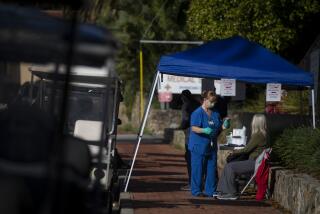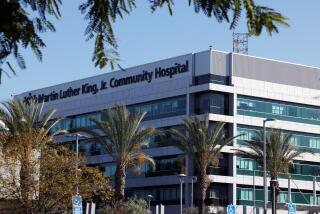Hospital’s Fund-Raising Drive Concludes on a Successful Note
- Share via
Santa Paula Memorial Hospital administrators have announced the successful end to a $500,000 fund-raising drive that will keep the doors open to the only emergency care facility in the Santa Clara Valley.
The community hospital has received donations and pledges worth $507,000 since the “Crisis Campaign” was unveiled six months ago, hospital officials said Tuesday.
“We are very gratified to know that--even in difficult financial times--people in our community recognized the value of our hospital and dug deep to come up with the money we needed,” hospital President Rulon J. Barlow said.
Support for the drive was widespread, he said, reminiscent of the 1962 drive in which the hospital’s founders raised $1 million in 30 days from valley residents to break ground.
The city of Fillmore donated $109,000, Santa Paula chipped in $35,000, and the remainder came from numerous civic groups and individuals.
Combined with cost-cutting moves--including a 5% across-the-board pay cut for the staff of 280--the donations will give the hospital two years’ breathing room, said Russ Hardison, a Fillmore rancher who is chairman of the hospital’s board of directors.
“If any small hospital our size can survive, we’ll be one of them,” Hardison said.
The campaign followed five years of mounting losses at the 60-bed facility, which provides the only emergency health care to the Santa Clara Valley communities of Santa Paula, Fillmore and Piru. Hospital officials blamed a rise in uninsured patients, cutbacks in government medical payments and a drop in patient admissions for the losses.
During the past two years, the nonprofit hospital has lost an average of $1 million on annual revenues of $24 million, Barlow said.
Over the past year, administrators shaved expenses by reducing the hospital’s staff by 12%, freezing wages, postponing repair projects and pursuing more favorable purchasing contracts. The hospital also stands to save $500,000 over five years by changing the method by which it pays for malpractice insurance, administrators said.
The hospital’s staff, a majority of which had already donated part of their salary to the fund-raising drive, are resigned to the additional cut, said Jim Duncan, a respiratory therapist who is chairman of Hilltoppers, an employee association that supports the hospital and its patients.
“The employees understand the predicament the hospital is in and want to try to keep it afloat,” Duncan said.
As part of the Hilltoppers’ fund-raising efforts, 152 of the hospital’s 280 employees volunteered part of their salary--totaling about $2,000 a month--while former and retired employees also contributed, Duncan said.
“The hospital is a major employer in the community,” Duncan said. “Most employees were real eager to help.”
Karin Lyders, the hospital’s director of nursing, said the nursing staff had already lost an average 18% of its salary during the year’s first quarter because of the low patient census.
Nevertheless, she said, nurses decided at a staff meeting to support an across-the-board wage cut rather than the elimination of higher-paying 12-hour shifts.
“The staff felt what transpired was as fair as it could be considering the circumstances,” Lyders said.
Santa Paula Mayor Margaret A. Ely credited the drive’s success to a well-organized campaign by volunteer fund-raiser William Ledbetter, who met with community groups and individuals for months to explain the hospital’s need.
Once residents realized how dire the hospital’s finances were, Ely said, the town responded as it has in the past.
“Anytime we have had a real need, the community bands together and makes things happen,” Ely said.
Councilman Roger Campbell of Fillmore expressed relief that a successful drive would ensure the hospital’s continued operation.
“That hospital is the key to life in our valley,” Campbell said. “In Santa Paula, if the hospital closed, it would mean an extra 10-minute ride to another hospital. In Fillmore, if that hospital is not there, it would mean an extra 30 to 40 minutes to a hospital. In my time with the (Fillmore) Fire Department, I’ve seen many times a shorter ride made the difference between life and death.”
More to Read
Sign up for Essential California
The most important California stories and recommendations in your inbox every morning.
You may occasionally receive promotional content from the Los Angeles Times.













